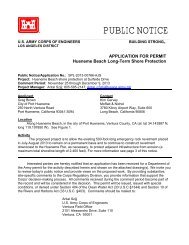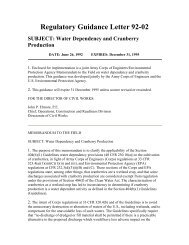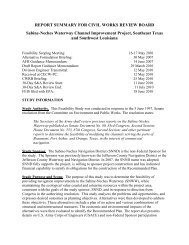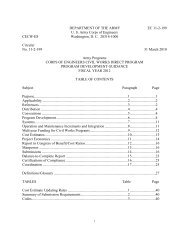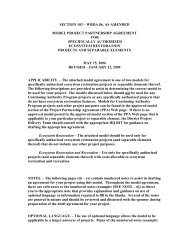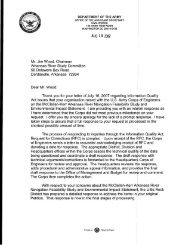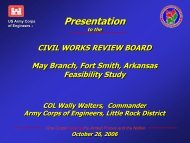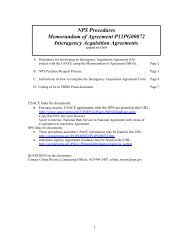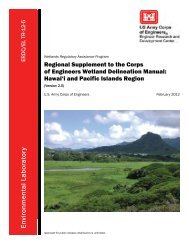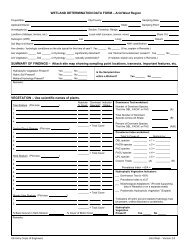Instructions - U.S. Army Corps of Engineers
Instructions - U.S. Army Corps of Engineers
Instructions - U.S. Army Corps of Engineers
Create successful ePaper yourself
Turn your PDF publications into a flip-book with our unique Google optimized e-Paper software.
<strong>Instructions</strong> for Preparing aDepartment <strong>of</strong> the <strong>Army</strong> Permit ApplicationBlocks 1 through 4. To be completed by <strong>Corps</strong> <strong>of</strong> <strong>Engineers</strong>.Block 5. Applicant’s Name. Enter the name and the E-mail address <strong>of</strong> the responsible party or parties. If theresponsible party is an agency, company, corporation, or other organization, indicate the name <strong>of</strong> the organizationand responsible <strong>of</strong>ficer and title. If more than one party is associated with the application, please attach a sheet withthe necessary information marked Block 5.Block 6. Address <strong>of</strong> Applicant. Please provide the full address <strong>of</strong> the party or parties responsible for the application.If more space is needed, attach an extra sheet <strong>of</strong> paper marked Block 6.Block 7. Applicant Telephone Number(s). Please provide the number where you can usually be reached duringnormal business hours.Blocks 8 through 11. To be completed, if you choose to have an agent.Block 8. Authorized Agent’s Name and Title. Indicate name <strong>of</strong> individual or agency, designated by you, torepresent you in this process. An agent can be an attorney, builder, contractor, engineer, or any other person ororganization. Note: An agent is not required.Blocks 9 and 10. Agent’s Address and Telephone Number. Please provide the complete mailing address <strong>of</strong> theagent, along with the telephone number where he / she can be reached during normal business hours.Block 11. Statement <strong>of</strong> Authorization. To be completed by applicant, if an agent is to be employed.Block 12. Proposed Project Name or Title. Please provide name identifying the proposed project, e.g., LandmarkPlaza, Burned Hills Subdivision, or Edsall Commercial Center.Block 13. Name <strong>of</strong> Waterbody. Please provide the name <strong>of</strong> any stream, lake, marsh, or other waterway to bedirectly impacted by the activity. If it is a minor (no name) stream, identify the waterbody the minor stream enters.Block 14. Proposed Project Street Address. If the proposed project is located at a site having a street address (nota box number), please enter it here.Block 15. Location <strong>of</strong> Proposed Project. Enter the latitude and longitude <strong>of</strong> where the proposed project is located.If more space is required, please attach a sheet with the necessary information marked Block 15.Block 16. Other Location Descriptions. If available, provide the Tax Parcel Identification number <strong>of</strong> the site,Section, Township, and Range <strong>of</strong> the site (if known), and / or local Municipality that the site is located in.Block 17. Directions to the Site. Provide directions to the site from a known location or landmark. Include highwayand street numbers as well as names. Also provide distances from known locations and any other information thatwould assist in locating the site. You may also provide description <strong>of</strong> the proposed project location, such as lotnumbers, tract numbers, or you may choose to locate the proposed project site from a known point (such as the rightdescending bank <strong>of</strong> Smith Creek, one mile downstream from the Highway 14 bridge). If a large river or stream,include the river mile <strong>of</strong> the proposed project site if knownBlock 18. Nature <strong>of</strong> Activity. Describe the overall activity or project. Give appropriate dimensions <strong>of</strong> structures suchas wing walls, dikes (identify the materials to be used in construction, as well as the methods by which the work is tobe done), or excavations (length, width, and height). Indicate whether discharge <strong>of</strong> dredged or fill material is involved.Also, identify any structure to be constructed on a fill, piles, or float-supported platforms.The written descriptions and illustrations are an important part <strong>of</strong> the application. Please describe, in detail, what youwish to do. If more space is needed, attach an extra sheet <strong>of</strong> paper marked Block 18.Block 19. Proposed Project Purpose. Describe the purpose and need for the proposed project. What will it be usedfor and why? Also include a brief description <strong>of</strong> any related activities to be developed as the result <strong>of</strong> the proposedproject. Give the approximate dates you plan to both begin and complete all work.
Block 20. Reasons for Discharge. If the activity involves the discharge <strong>of</strong> dredged and/or fill material into a wetlandor other waterbody, including the temporary placement <strong>of</strong> material, explain the specific purpose <strong>of</strong> the placement <strong>of</strong>the material (such as erosion control).Block 21. Types <strong>of</strong> Material Being Discharged and the Amount <strong>of</strong> Each Type in Cubic Yards. Describe thematerial to be discharged and amount <strong>of</strong> each material to be discharged within <strong>Corps</strong> jurisdiction. Please be sure thisdescription will agree with your illustrations. Discharge material includes: rock, sand, clay, concrete, etc.Block 22. Surface Areas <strong>of</strong> Wetlands or Other Waters Filled. Describe the area to be filled at each location.Specifically identify the surface areas, or part there<strong>of</strong>, to be filled. Also include the means by which the discharge is tobe done (backhoe, dragline, etc.). If dredged material is to be discharged on an upland site, identify the site and thesteps to be taken (if necessary) to prevent run<strong>of</strong>f from the dredged material back into a waterbody. If more space isneeded, attach an extra sheet <strong>of</strong> paper marked Block 22.Block 23. Description <strong>of</strong> Avoidance, Minimization, and Compensation. Provide a brief explanation describinghow impacts to waters <strong>of</strong> the United States are being avoided and minimized on the project site. Also provide a briefdescription <strong>of</strong> how impacts to waters <strong>of</strong> the United States will be compensated for, or a brief statement explaining whycompensatory mitigation should not be required for those impacts.Block 24. Is Any Portion <strong>of</strong> the Work Already Complete? Provide any background on any part <strong>of</strong> the proposedproject already completed. Describe the area already developed, structures completed, any dredged or fill materialalready discharged, the type <strong>of</strong> material, volume in cubic yards, acres filled, if a wetland or other waterbody (in acresor square feet). If the work was done under an existing <strong>Corps</strong> permit, identity the authorization, if possible.Block 25. Names and Addresses <strong>of</strong> Adjoining Property Owners, Lessees, etc., Whose Property Adjoins theProject Site. List complete names and full mailing addresses <strong>of</strong> the adjacent property owners (public and private)lessees, etc., whose property adjoins the waterbody or aquatic site where the work is being proposed so that theymay be notified <strong>of</strong> the proposed activity (usually by public notice). If more space is needed, attach an extra sheet <strong>of</strong>paper marked Block 24.Information regarding adjacent landowners is usually available through the <strong>of</strong>fice <strong>of</strong> the tax assessor in thecounty or counties where the project is to be developed.Block 26. Information about Approvals or Denials by Other Agencies. You may need the approval <strong>of</strong> otherfederal, state, or local agencies for your project. Identify any applications you have submitted and the status, if any(approved or denied) <strong>of</strong> each application. You need not have obtained all other permits before applying for a <strong>Corps</strong>permit.Block 27. Signature <strong>of</strong> Applicant or Agent. The application must be signed by the owner or other authorized party(agent). This signature shall be an affirmation that the party applying for the permit possesses the requisite propertyrights to undertake the activity applied for (including compliance with special conditions, mitigation, etc.).General Information.DRAWINGS AND ILLUSTRATIONSThree types <strong>of</strong> illustrations are needed to properly depict the work to be undertaken. These illustrations or drawingsare identified as a Vicinity Map, a Plan View or a Typical Cross-Section Map. Identify each illustration with a figure orattachment number.Please submit one original, or good quality copy, <strong>of</strong> all drawings on 8½ x11 inch plain white paper (electronic mediamay be substituted). Use the fewest number <strong>of</strong> sheets necessary for your drawings or illustrations.Each illustration should identify the project, the applicant, and the type <strong>of</strong> illustration (vicinity map, plan view, or crosssection).While illustrations need not be pr<strong>of</strong>essional (many small, private project illustrations are preparedby hand), they should be clear, accurate, and contain all necessary information.



